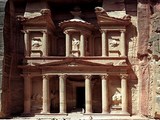 |
 |
Jordan : Petra and the Nabateans
Petra, located in a valley bordered by mountains, was occupied around the 6th century BC by the Nabataeans.
They made it prosper thanks to its ideal trading location, on the caravan trails transporting incense, spices and other luxury products between Egypt, Syria, Southern Arabia and the
Mediterranean. In the 4th century BC, the town spread over 10 kilometres.
Al-Siq, the long, narrow and sinuous natural passageway, is the entrance to the antique city.
Its largest breadth is only a few metres, and is tens of metres in height, making it a strategic defence point.
|


